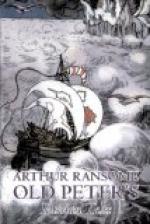“There’s something new in the village.”
“What sort of a something?” asked Vanya.
“Alive,” said old Peter.
“Is there a lot of it?” asked Vanya.
“No, only one.”
“Then it can’t be pigs,” said Vanya, in a melancholy voice. “I thought it was pigs.”
“Perhaps it is a little calf,” said Maroosia.
“I know what it is,” said Vanya.
“Well?”
“It’s a foal. It’s brown all over with white on its nose, and a lot of white hairs in its tail.”
“No.”
“What is it then, grandfather?”
“I’ll tell you, little pigeons. It’s small and red, and it’s got a bumpy head with hair on it like the fluff of a duckling. It has blue eyes, and ten fingers to its fore paws, and ten toes to its hind feet—five to each.”
“It’s a baby,” said Maroosia.
“Yes. Nastasia has got a little son, Aunt Sofia has got a grandson, you have got a new cousin, and I have got a new great-nephew. Think of that! Already it’s a son, and a cousin, and a grandson, and a great-nephew, and he’s only been alive twelve hours. He lost no time in taking a position for himself. He’ll be a great man one of these days if he goes on as fast as that.”
The children had jumped up as soon as they knew it was a baby.
“When is the christening?”
“The day after to-morrow.”
“O grandfather!”
“Well?”
“Who is going to the christening?”
“The baby, of course.”
“Yes; but other people?”
“All the village.”
“And us?”
“I have to go, and I suppose there’ll be room in the cart for two little bear cubs like you.”
And so it was settled that Vanya and Maroosia were to go to the christening of their new cousin, who was only twelve hours old. All the next day they could think of nothing else, and early on the morning of the christening they were up and about, Maroosia seeing that Vanya had on a clean shirt, and herself putting a green ribbon in her hair. The sun shone, and the leaves on the trees were all new and bright, and the sky was pale blue through the flickering green leaves.
Old Peter was up early too, harnessing the little yellow horse into the old cart. The cart was of rough wood, without springs, like a big box fixed on long larch poles between two pairs of wheels. The larch poles did instead of springs, bending and creaking, as the cart moved over the forest track. The shafts came from the front wheels upwards to the horse’s shoulders, and between the ends of them there was a tall strong hoop of wood, called a douga, which rose high over the shoulders of the horse, above his collar, and had two little bells hanging from it at the top. The wooden hoop was painted green with little red flowers. The harness was mostly of ropes, but that did not matter so long as it held together. The horse had a long tail and mane, and looked as untidy as a little boy; but he had a green ribbon in his forelock in honour of the christening, and he could go like anything, and never got tired.




